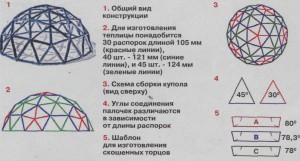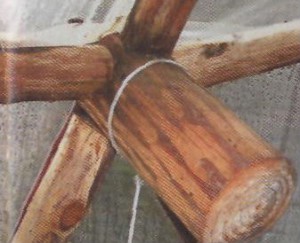 The idea to build this original greenhouse I was suggested by goats, before the time of the winter reserve of the hay. In March, it was necessary to feed their goat Yoya, the benefit on the nearest edge of the forest she stood a frequency. As a result, we have accumulated a lot of compelling stems. I thought: how to use them? And then I remembered about geokuple.designed in the middle of the last century. There was an idea to make from these svolics circular greenhouse with reservoir. For the construction, I was required of these trunks with a diameter of 2.5-3 cm. Cut chopsticks: 30 pcs. 105 mm long, 40 pcs. 121 mm and 45 pcs. 124 mm. In addition to them, it was necessary to prepare more and connecting elements - nodes in the amount of 46 pcs. So I suffered greatly with them. In the aftertell, she finally waved his hand on the recommendation and did not make it easier: I found a dry triber bag in the forest with a diameter of about 60-80 mm in a diameter of a diameter of about 60-80 mm and walked them with sections of 160 mm. I cleared them from the bark, I spent the edges and decided that this was enough.
The idea to build this original greenhouse I was suggested by goats, before the time of the winter reserve of the hay. In March, it was necessary to feed their goat Yoya, the benefit on the nearest edge of the forest she stood a frequency. As a result, we have accumulated a lot of compelling stems. I thought: how to use them? And then I remembered about geokuple.designed in the middle of the last century. There was an idea to make from these svolics circular greenhouse with reservoir. For the construction, I was required of these trunks with a diameter of 2.5-3 cm. Cut chopsticks: 30 pcs. 105 mm long, 40 pcs. 121 mm and 45 pcs. 124 mm. In addition to them, it was necessary to prepare more and connecting elements - nodes in the amount of 46 pcs. So I suffered greatly with them. In the aftertell, she finally waved his hand on the recommendation and did not make it easier: I found a dry triber bag in the forest with a diameter of about 60-80 mm in a diameter of a diameter of about 60-80 mm and walked them with sections of 160 mm. I cleared them from the bark, I spent the edges and decided that this was enough. 
 Similarly entered the other wand. And so, the triangle behind the triangle, exactly according to the scheme assembled the upper pentagonal design. And then it began to attach the following triangles so, a wand for a stick and collected the entire frame. I repeat once again: it was from top to bottom. AND door to greenhouse, and I did the triangular window already from the same IV wands. Then I collected the brigade of seven friends, and we moved the frame to his permanent place by installing the foundation from bricks. To
Similarly entered the other wand. And so, the triangle behind the triangle, exactly according to the scheme assembled the upper pentagonal design. And then it began to attach the following triangles so, a wand for a stick and collected the entire frame. I repeat once again: it was from top to bottom. AND door to greenhouse, and I did the triangular window already from the same IV wands. Then I collected the brigade of seven friends, and we moved the frame to his permanent place by installing the foundation from bricks. To  The dome was not taken by the wind, the stakes were killed in the ground and the bottom nodes were screwed to them. And here we wondered: than to cover the greenhouse and how to do it? After all, the frame looked so fragile that it seemed: Tkni's finger - and fall apart! But I still risked and, putting the staircase outside to the future greenhouse, began to slowly climb up. My fears were in vain: these fragile sticks were kept and my weight is 75 kg, and the staircase. We covered the greenhouse film "Svetlitsa". It is painfully the assurances of the manufacturer about the 7-year term of the underfloor material. Although the dome turned out to be difficult and long. We started at the bottom, a row for nearby, cutting off the film and fixing it with a staple with the help of a tight film strips. At the bottom, the film was cut off with the reserve: the surplus was put on the ground and poured the ground - it turned out a garden surrounding the greenhouse where the wife immediately landed flowers. In general, in my opinion, it is worth making a finished cover from the film, just throw it on
The dome was not taken by the wind, the stakes were killed in the ground and the bottom nodes were screwed to them. And here we wondered: than to cover the greenhouse and how to do it? After all, the frame looked so fragile that it seemed: Tkni's finger - and fall apart! But I still risked and, putting the staircase outside to the future greenhouse, began to slowly climb up. My fears were in vain: these fragile sticks were kept and my weight is 75 kg, and the staircase. We covered the greenhouse film "Svetlitsa". It is painfully the assurances of the manufacturer about the 7-year term of the underfloor material. Although the dome turned out to be difficult and long. We started at the bottom, a row for nearby, cutting off the film and fixing it with a staple with the help of a tight film strips. At the bottom, the film was cut off with the reserve: the surplus was put on the ground and poured the ground - it turned out a garden surrounding the greenhouse where the wife immediately landed flowers. In general, in my opinion, it is worth making a finished cover from the film, just throw it on  frame and fix from below. Now about how there is a pond in the greenhouse. It was possible to give it the necessary form with the help of all the same logged sticks - I scored them in the ground along the contour of the pond and made from short boards. Then he lied the pit with a special pond film and sand fell asleep cavity outside. On the edges of the pond we laid pebbles. The pond turned out in the form of beolines, 1 m deep. Attached it about 2 cubic meters of water from the well. While I finished the bed and the pond, my wife framed their pebbles beautifully and all the time I rushed something to put ahead of time. But the time came, and in the greenhouse placed seedlings. As an experiment, we planted there tomatoes, cucumbers, watermelons, melons, peppers, eggplants. I put cups with asparagus, seedlings, and in the center of the greenhouse for some reason
frame and fix from below. Now about how there is a pond in the greenhouse. It was possible to give it the necessary form with the help of all the same logged sticks - I scored them in the ground along the contour of the pond and made from short boards. Then he lied the pit with a special pond film and sand fell asleep cavity outside. On the edges of the pond we laid pebbles. The pond turned out in the form of beolines, 1 m deep. Attached it about 2 cubic meters of water from the well. While I finished the bed and the pond, my wife framed their pebbles beautifully and all the time I rushed something to put ahead of time. But the time came, and in the greenhouse placed seedlings. As an experiment, we planted there tomatoes, cucumbers, watermelons, melons, peppers, eggplants. I put cups with asparagus, seedlings, and in the center of the greenhouse for some reason 
 technologies). When entering inside, you experience very comfortable sensations. Probably, the plants felt it: they grew and bloomed so rapidly that she was very quickly formed solid jungle. Juicy and sweet melons, the largest of which pulled 2 kg, a huge amount of cucumbers, tomatoes, eggplants, peppers, watermelons ... True, with watermelons we were disappointing. Large, weight of almost 3 kg, bright red, fragrant, juicy, literally blasting under the knife. And the taste is like an old cucumber. Well, maybe a little easily. As we explained to the knowledgeable people, it was necessary to stop them to water 2-3 weeks before cutting, so that sweets would come. Well, there will be science to us. It means that it is necessary to plant watermelons a little away, and we have grew near the eggplant: they walked eggplant - "drank" and watermelon. So in general, experience, I think it turned out to be successful. An amazing mini-oasis with a pond inside presented us a lot of surprises. For example, in a conventional greenhouse, the cucumbers got sick: they hit the cobweb tick. Here he was not given to "get roaring": a huge number of ladybugs was divorced under the film dome. Although perhaps it is just a coincidence. But we, of course, is only good.
technologies). When entering inside, you experience very comfortable sensations. Probably, the plants felt it: they grew and bloomed so rapidly that she was very quickly formed solid jungle. Juicy and sweet melons, the largest of which pulled 2 kg, a huge amount of cucumbers, tomatoes, eggplants, peppers, watermelons ... True, with watermelons we were disappointing. Large, weight of almost 3 kg, bright red, fragrant, juicy, literally blasting under the knife. And the taste is like an old cucumber. Well, maybe a little easily. As we explained to the knowledgeable people, it was necessary to stop them to water 2-3 weeks before cutting, so that sweets would come. Well, there will be science to us. It means that it is necessary to plant watermelons a little away, and we have grew near the eggplant: they walked eggplant - "drank" and watermelon. So in general, experience, I think it turned out to be successful. An amazing mini-oasis with a pond inside presented us a lot of surprises. For example, in a conventional greenhouse, the cucumbers got sick: they hit the cobweb tick. Here he was not given to "get roaring": a huge number of ladybugs was divorced under the film dome. Although perhaps it is just a coincidence. But we, of course, is only good.
On a note:
Before getting the material to cover the roof, any builder will first consider how much material is needed and what there will be its cost. If you count from the point of view of savings, it is possible as a roof cover to use ondulin, since the price of an anduulin coating for the roof Pretty acceptable.
This roofing material is very light, therefore it is used to repair an old slate or other coating, laying the sheets simply over it. If you wish to completely inspire and sew a balcony in your home or apartment, Ondulin will be an excellent option for its coverage.













 Start a discussion ...
Start a discussion ...